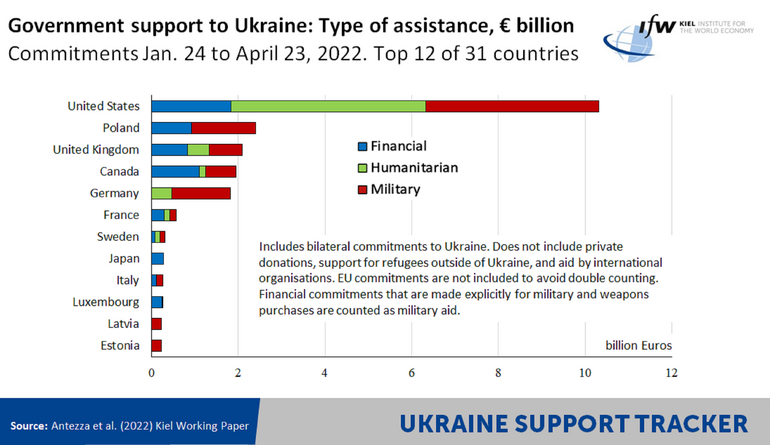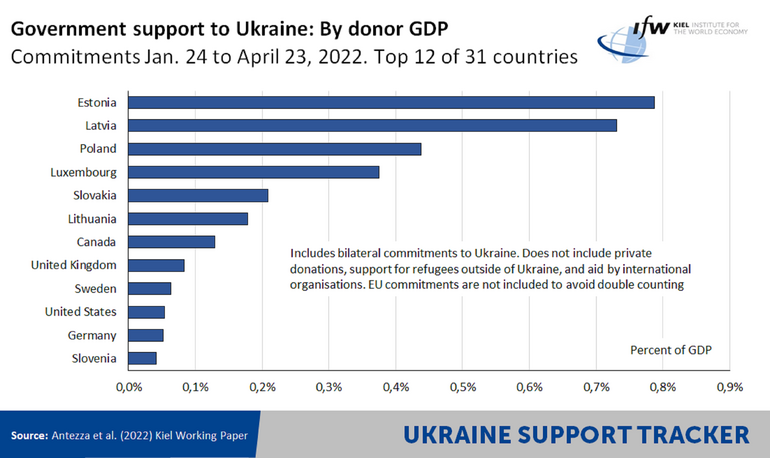News
Ukraine Support Tracker: EU countries catch up and reach US level
Many countries are pledging additional military, humanitarian, or financial support to Ukraine and are making their help more transparent. The Kiel Institute for the World Economy's Ukraine Support Tracker systematically records the value of publicly known government-to-government support to Ukraine by 31 Western countries. The update covers commitments announced between January 24, 2022, about a month before the Russian invasion began, and April 23, 2022.
According to the data collected, the U.S. remains by far the largest current supporter of Ukraine, with the equivalent of 10.3 billion euros since the end of January, and has already announced the next significant increase in its commitment. All EU countries combined, including funds pledged by EU institutions and the European Investment Bank, now total 12.8 billion euros. Germany, which has been criticized for its hesitancy in supporting Ukraine, now ranks 5th among donor countries behind Poland, the UK, and Canada. If one adds funds pledged indirectly via the EU, Germany is Ukraine's second-largest supporter in absolute terms. However, the non-transparent way in which data is published means that there is a risk of double counting commitments by EU countries.

“Taken together, the contributions of EU countries currently reach the magnitude of U.S. aid, which should be expected given the geographic proximity to Ukraine,” says Christoph Trebesch, research director at Kiel Institute and responsible for the Ukraine Support Tracker. “However, it is surprising that among the top 5 donor countries, only two are from the EU. Unlike Germany and Poland, countries such as France, Spain, or Italy have fallen further behind, with only comparatively small new commitments in the past weeks.”
In addition, the U.S. announced a major new support package for Ukraine a few days ago. President Biden has proposed a law to raise an additional 33 billion US-Dollar. “This is a remarkable amount that dwarfs all previous support announcements for Ukraine,” says Trebesch. “If you add this package, the U.S. will have committed four times as much as all EU countries combined.” The current Ukraine Support Tracker dataset does not yet include the new U.S. announcement, which has yet to be approved by the U.S. Congress.
“We are observing an increased willingness by governments to offer support to Ukraine and to do so transparently. For the public debate, it is essential that governments make their commitments public and comparable on the basis of facts. The Ukraine Support Tracker is intended to contribute to this by gathering and cleaning that information that has become public,“ says Trebesch.
In relation to economic output, Estonia is Ukraine's biggest supporter, followed by Latvia and Poland. The U.S. and Germany rank on 10th and 11th place respectively, each contributing around 0.05 percent of their gross domestic product according to the available data.

“The support provided to Ukraine has grown steadily in the second month of the war. However, the total amount of aid provided, especially by larger countries, is still modest compared with the sums mobilized in previous crises. Or even compared to the support packages that countries put together for their own populations, for example to cushion energy price increases,“ says Trebesch.
Note: In an earlier version, the text stated that Lithuania was the second largest supporter of the Ukraine in terms of its own GDP; in fact, according to the data, it is Latvia. We have corrected this.
____________________________
About the Ukraine Support Tracker
The Ukraine Support Tracker lists and quantifies military, financial and humanitarian aid pledged to Ukraine since January 24, 2022. It focuses on 31 countries, specifically the EU states and the other members of the G7. Donations by the EU Commission and the European Investment Bank are also included. The tracker lists government-to-government commitments; private donations or those from international organizations such as the IMF are not included in this version. Nor does it include flows going into countries like, for example, Moldova, which has received financial support to deal with the large number of Ukrainian refugees.
With regard to sources, the database combines official government sources with information from international media. Aid provided in kind, such as medical supplies, food or military equipment, is quantified on the basis of market prices or information from previous aid campaigns. In cases of doubt, upper bounds of prices are used.
The now released version of the Ukraine Support Tracker is a preliminary (beta) version, which will be continuously expanded, corrected and improved in the coming weeks. Any help to improve the tracker is very welcome and can be sent to ukrainetracker@ifw-kiel.de.
More information and data can be found on this webpage: Ukraine Support Tracker
